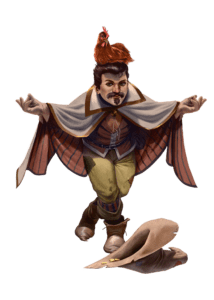
Roleplaying in a game is one of the most effective ways a player can interface with their character and immerse themselves into the world of the game. A common concern among newer players however, is that they don’t believe they can think on their feet.
Luckily, it’s easy to cultivate improvisation skills! The dirty secret of improv is that you can practice it. You’re at the table anyway, so try these games and tools to improve your skills.
Catch up on all installments of Improv Proficiency!
The final tool to help bring them all the improv strategies together is active listening.
As opposed to passive listening, where you ambiently hear the things around you, active listening requires your attention. You seek out certain prompts or ideas from your fellow players.
This concept is the glue that holds any good scene together. Without it, players wind up building their own scenes at the same time, not working together. (Remember, in this context a “scene” is any moment of a game in which roleplaying is in the forefront.)
Make a Perception Check
Active listening means putting in conscious effort to listen to what your fellow players are saying and doing. No matter your role in a scene, whether you are a player or GM, active listening will help you accomplish two things with your roleplaying.
1. It keeps you present and attentive. A player who listens and engages with what they are listening to is a player who respects the game and the effort to play it by others.
2. It makes roleplay much easier. Active listening allows you to pick up prompts that you can use to springboard into full roleplay. These prompts keep you ready to improvise at a moment’s notice with constructive ideas.
LARCH Prompt
Every scene is built on the foundation of LARCH (Location, Action, Relationship, Character, and History). As a scene is set up by the GM and other players begin to roleplay within it, listen for any of the five scene aspects that are absent.
Make it your job to add what’s missing. This makes the scene stronger and gives the other players ideas to roleplay off of.
The First Unusual Thing Prompt
TTRPGs are designed with objectives for the players to accomplish, so scenes should also have objectives. The first unusual thing (see Improv Proficiency 3: Games Within the Game) is a starting point to create a minigame objective within a scene. When you or another player have identified something as the first unusual thing, it must be clearly communicated in character that it has been identified.
Player 1: Wait, the dragon tends to avoid areas with lots of smoke? Maybe it has asthma?
Player 2: A dragon with asthma?! (signaling to other players the first unusual thing by repeating what was said)
Player 3: Maybe it needs to see a doctor for its asthma? (acknowledging the first unusual thing pointed out by Player 2)
When another player repeats something in this way, that’s your signal. They’re prompting others at the table (YOU) to interact with the first unusual thing. Listen for this prompt to find common ground with the players in the scene.
Don’t Mess With the Baby Prompt
One of a GM’s many responsibilities is laying out an encounter or scene and describing what is present for players to interact and roleplay with. At the center of these descriptions is usually the “baby,” or the central idea of a scene (see Improv Proficiency: Don’t Mess With the Baby).
As simple as it sounds, actively listen to your GM’s narration to identify the baby. From there, you decide whether you mess with it!
Scene Energy Prompt
A GM can intend for a scene to have a certain mood or energy. They can communicate that energy to players in the way they speak and describe things.
As a player, listen for that energy. It’s your signal to you of how things should initially proceed in a scene.
Communication is King
The ultimate goal in all of this is to help players practice to improvise and roleplay completely in character. Developing these skills takes time. And practice! It might be tricky to get the ball rolling in your first scenes, and you may not do things perfectly on your first try.
When things don’t go smoothly, it is OK to ask for clarification out of character. Don’t feel embarrassed to ask other players what they think the first unusual thing is, or to ask the GM directly what type of energy they want a scene to have.
Frequently, other players will be grateful that you are considering their thoughts before you decide your next move. You might even help another hesitant player out by asking for more clear and concise information to use.
Stay in communication with everyone else at the table, and there is really no way to mess up improv. It’s all made up anyway!
For more insight into how the games are played and made, told by the pros, check out Kobold Guides!
The Kobold Guide to Worldbuilding gets you inside info on making your world more fun and real.
The Kobold Guide to Gamemastering gives you tips and structure for upping for GM game!
And there are many more Kobold Guides, waiting for you!
